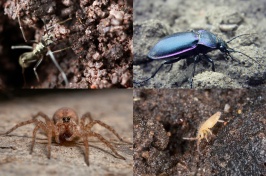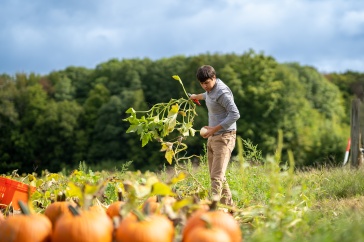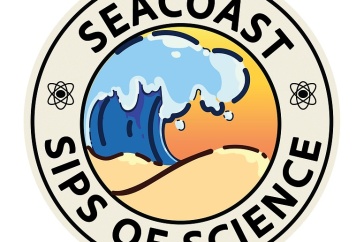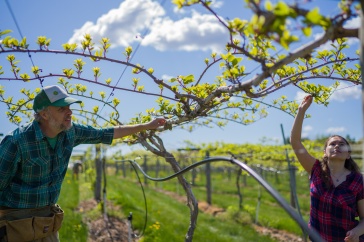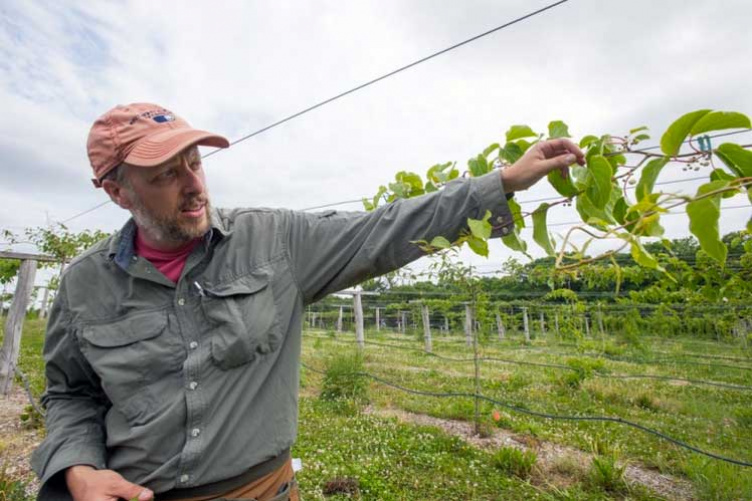
If Iago Hale has his way, in a few years you may be topping your breakfast cereal with a handful of fresh kiwiberries you bought at your local farmer’s market. That’s right, local kiwi. In northern New England.
Working to develop the fruit into a new high-value crop for New England farmers, Hale, UNH assistant professor of specialty crop improvement and a plant breeder, has planted an acre of cold-hardy kiwis at UNH’s Woodman Farm. The sweet, smooth-skinned, grape-sized cousin to New Zealand’s fuzzy fruit is
native to northern Asia and has been grown as an ornamental vine in the Northeast for more than a century.
“Through breeding, my objective is to turn this edible landscaping plant into a vine that flourishes within a commercial production system,” Hale says.
Kiwiberries could be a winning crop for the small-scale, very diverse agriculture of the Northeast. “It’s a perennial species, which from a soil health perspective is a great advantage,” says Hale. Also, because the fruits have a relatively short storage life (up to six weeks, compared to six months or more for fuzzy kiwis), global commodity-minded agricultural research enterprises have given kiwiberries a pass. “But within our region, reduced storability is an insurance plan,” he says, minimizing the risk that local producers will one day be undercut by imported kiwiberries from abroad.
Plus, Hale says, hardy kiwis taste wonderful — sweet with a tropical fruit complexity — and are packed with nutritional overachievers like vitamin C, beta-carotene, anthocyanins and lutein.
Before encouraging farmers in the state to plant vines, however, Hale is doing due diligence as befits UNH’s land-grant mission to bring vetted research to those who can use it.
With funding from the U.S. Department of Agriculture through the New Hampshire Agricultural Experiment Station at UNH, he’s currently screening nearly 200 different varieties of kiwiberries, putting them through the same paces a potential commercial grower would to assess their economic viability.
“We trellis them, prune them, fertilize and irrigate them and observe, observe, observe. Over the seasons, we get a sense of which ones are promising and which are not,” he says. “One vine may have great-tasting fruit, while another may tolerate late-spring frosts better. This information informs the crosses we make.”
This fall, three years after they were planted, the initial population of vines bore a small harvest of kiwiberries. While it was far less than the 70-plus pounds of fruit each plant is expected to bear at full maturity, “it is enough for us to do some preliminary screening for fruit quality as well as some basic post-harvest studies,” Hale says. He and Will Hastings ’16, a student in the sustainable agriculture and food systems major, will investigate how the berries hold up to storage, handling and other aspects of the journey from farm to consumer. Hale describes their work as shifting the odds for success in the producer’s favor.
“We know that breeding works,” he says, “but it takes time. Our challenge is to be smart about it, to use all the available tools to speed up the process, taming this wild plant to produce consistent, uniform berries in a matter of years instead of decades.”
Then there’s the marketing: “You need consumers, who currently live quite well without kiwiberries, to buy them. There are a lot of moving parts.”
Overcoming these obstacles, however, could do more than bring a new berry to the table: Hale thinks the kiwiberry could stimulate economic activity across the state, even in areas like New Hampshire’s North Country.
“There is potential here for an entirely new agricultural industry, one on par with the economic impact of strawberries and blueberries,” Hale says. “We’re talking millions of dollars of revenue, tourism, jobs. Through diversification like this, we may be able to enhance farm viability in the state. It’s a potential I have to explore.”
Originally published in UNH Magazine—Fall 2015 Issue
-
Written By:
Beth Potier | UNH Marketing | beth.potier@unh.edu | 2-1566































